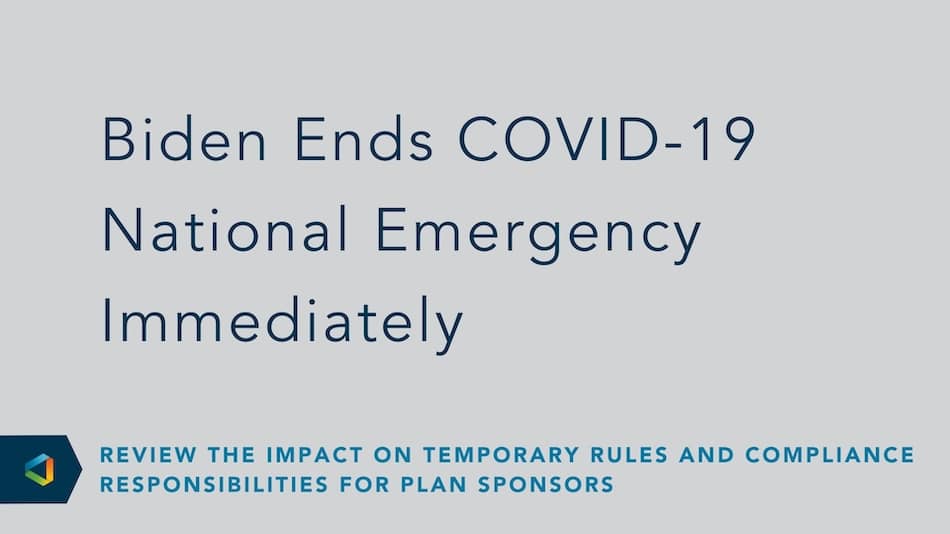Better Benefits, No Headaches
Responding to the Business Impacts of COVID-19
Responding to the Business Impacts of COVID-19
The past month has been a friendly reminder of how quickly business, professional and economic priorities can change. Less than a month ago, the U.S. economy was thriving. The Dow Jones and S&P 500 indices hit record highs and unemployment was at record lows. Now, the outbreak of an invisible “bug” known as COVID-19 has wreaked havoc and uncertainty across the globe.
As of this writing, the Dow Jones and S&P 500 indices are down more than 20%. Higher education and municipalities across the country have suspended school and are evaluating virtual learning for the first time. Major sporting events at the professional, collegiate, and high school levels have been suspended or canceled. The concept of social distancing has become part of our everyday nomenclature.
The initial impact of and ongoing response to COVID-19 has been rapid and remains very fluid and uncertain. This uncertainty has and will continue to impact businesses and the workforce in several ways. Examples include how to keep employees safe, how to keep employees working, how to maintain and leverage health and welfare benefits, and how to manage retirement plans. Additionally, business leaders are concerned with how the economic downturn will impact ongoing operations.
Analysts at McKinsey & Company assessed the current situation and past pandemics, outlining three economic scenarios:
- Quick Recovery
- Global Slowdown
- Global Pandemic and Recession
Quick Recovery suggests the world would see a relatively quick end to the outbreak, maybe as soon as the end of 1Q 2020. It also assumes the virus will be seasonal. In the Global Slowdown scenario, the world would experience an economic downturn through 2Q 2020, driven by industries that have been hit hardest. In the worst-case scenario, Global Pandemic and Recession, a brief recovery and return to pre-outbreak routines induces a resumption of new transmissions, resulting in a global recession through 3Q 2020 or beyond. A significant element of each scenario for businesses is the reliance of supply chains to and from China.
In the meantime, we recommend that businesses follow clear steps to manage the situation proactively and to mitigate the impact on ongoing operations:
-
Establish a COVID-19 Task Force
This cross-functional team is responsible for monitoring trusted sources for ongoing information to share with leadership, employees, customers, and other stakeholders. The Centers for Disease Control and Prevention (CDC), World Health Organization (WHO), the United States Government, and the Occupational Safety and Health Administration (OSHA) are strong, factual resources. This group should also lead and develop a crisis management plan.
-
Develop and Execute a Crisis Management Plan
If a crisis management plan exists, put it into action. If not, develop a plan to manage the crisis, focusing on key objectives such as protecting and communicating to employees, evaluating, updating, and/or developing policies and procedures that will mitigate the financial impact on the business. The plan should also include strategies for keeping customers updated on the situation, instilling confidence in their partnership with your organization.
-
Focus on Employees
Employees will undoubtedly have questions relative to general safety, remote work and other workplace policies, health and welfare benefits, 401(k) impact, the long-term sustainability of the business, etc. We recommend that the COVID-19 Task Force be in constant contact with the following in-house resources or teams to develop answers to commonly asked employee questions:
- In-House Communications Team: Keep employees informed by providing ongoing updates to them.
- In-House Safety Team: Keep employees safe by reviewing and updating current policies such as remote work policies.
- Legal Counsel: Protect employees and take advantage of any current and pending federal and state legislation that may have a positive impact on your workforce.
- Employee Benefits/HR/Wellbeing Consultants: Provide your employees with peace of mind and make available information and guidance on how employees can navigate their health and welfare benefits during the crisis.
- Financial Advisor: Provide your employees with resources and make information and guidance on how employees can manage their retirement investments during the crisis available.
-
Communicate with Customers
Keep customers abreast of how the outbreak is impacting your business and the steps you are taking to mitigate any shock on ongoing operations. Reference any supply chain disruption, if applicable. Keep in mind the tone you use and the frequency with which you are communicating, trying not to contribute to the panic.
-
Execute the Plan
Actively manage the plan, and be fluid. We saw how quickly COVID-19 evolved into a national pandemic, rapidly changing the priorities of businesses. It is in the best interest of business leaders to consistently look ahead and prepare for any additional disruption that will impact their workforce and bottom line.
The COVID-19 situation is an unprecedented event and one of the most significant health-related pandemics of many of today’s generations’ lifetimes. The uncertainty will continue to be part of our everyday lives, at least for the next several weeks. Businesses should allocate the appropriate attention and resources to the problem to mitigate as much risk as possible to employees and the company.
For up to date information and guidance on how businesses can weather the storm amid the COVID-19 pandemic, visit the OneDigital Coronavirus Advisory Hub.
Sources:
www.tradingeconomics.com/indicators
https://www.mckinsey.com/business-functions/risk/our-insights/covid-19-implications-for-business
https://www.pwc.com/us/en/library/covid-19/crisis-management.html
https://www.shrm.org/resourcesandtools/hr-topics/benefits/pages/health-wellness-leave-benefits-help-employees-with-coronavirus.aspx




